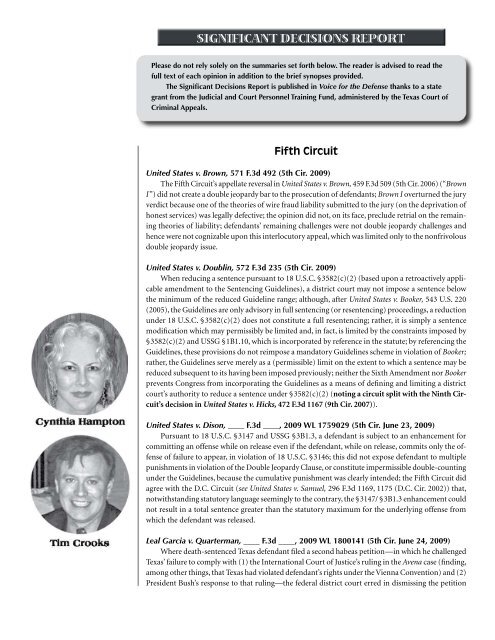for the defense for the defense - Voice For The Defense Online
for the defense for the defense - Voice For The Defense Online
for the defense for the defense - Voice For The Defense Online
Create successful ePaper yourself
Turn your PDF publications into a flip-book with our unique Google optimized e-Paper software.
Significant Decisions Report<br />
Please do not rely solely on <strong>the</strong> summaries set <strong>for</strong>th below. <strong>The</strong> reader is advised to read <strong>the</strong><br />
full text of each opinion in addition to <strong>the</strong> brief synopses provided.<br />
<strong>The</strong> Significant Decisions Report is published in <strong>Voice</strong> <strong>for</strong> <strong>the</strong> <strong>Defense</strong> thanks to a state<br />
grant from <strong>the</strong> Judicial and Court Personnel Training Fund, administered by <strong>the</strong> Texas Court of<br />
Criminal Appeals.<br />
Fifth Circuit<br />
United States v. Brown, 571 F.3d 492 (5th Cir. 2009)<br />
<strong>The</strong> Fifth Circuit’s appellate reversal in United States v. Brown, 459 F.3d 509 (5th Cir. 2006) (“Brown<br />
I”) did not create a double jeopardy bar to <strong>the</strong> prosecution of defendants; Brown I overturned <strong>the</strong> jury<br />
verdict because one of <strong>the</strong> <strong>the</strong>ories of wire fraud liability submitted to <strong>the</strong> jury (on <strong>the</strong> deprivation of<br />
hon est services) was legally defective; <strong>the</strong> opinion did not, on its face, preclude retrial on <strong>the</strong> remaining<br />
<strong>the</strong>ories of liability; defendants’ remaining challenges were not double jeopardy challenges and<br />
hence were not cognizable upon this interlocutory appeal, which was limited only to <strong>the</strong> nonfrivolous<br />
dou ble jeopardy issue.<br />
Cynthia Hampton<br />
TIm Crooks<br />
United States v. Doublin, 572 F.3d 235 (5th Cir. 2009)<br />
When reducing a sentence pursuant to 18 U.S.C. §3582(c)(2) (based upon a retroactively ap plica<br />
ble amendment to <strong>the</strong> Sentencing Guidelines), a district court may not impose a sentence below<br />
<strong>the</strong> minimum of <strong>the</strong> reduced Guideline range; although, after United States v. Booker, 543 U.S. 220<br />
(2005), <strong>the</strong> Guidelines are only advisory in full sentencing (or resentencing) proceedings, a reduction<br />
un der 18 U.S.C. §3582(c)(2) does not constitute a full resentencing; ra<strong>the</strong>r, it is simply a sentence<br />
mod i fi ca tion which may permissibly be limited and, in fact, is limited by <strong>the</strong> constraints imposed by<br />
§3582(c)(2) and USSG §1B1.10, which is incorporated by reference in <strong>the</strong> statute; by referencing <strong>the</strong><br />
Guide lines, <strong>the</strong>se provisions do not reimpose a mandatory Guidelines scheme in violation of Booker;<br />
ra<strong>the</strong>r, <strong>the</strong> Guidelines serve merely as a (permissible) limit on <strong>the</strong> extent to which a sentence may be<br />
re duced subsequent to its having been imposed previously; nei<strong>the</strong>r <strong>the</strong> Sixth Amendment nor Booker<br />
pre vents Congress from incorporating <strong>the</strong> Guidelines as a means of defining and limiting a district<br />
court’s authority to reduce a sentence under §3582(c)(2) (noting a circuit split with <strong>the</strong> Ninth Circuit’s<br />
decision in United States v. Hicks, 472 F.3d 1167 (9th Cir. 2007)).<br />
United States v. Dison, ____ F.3d ____, 2009 WL 1759029 (5th Cir. June 23, 2009)<br />
Pursuant to 18 U.S.C. §3147 and USSG §3B1.3, a defendant is subject to an enhancement <strong>for</strong><br />
com mitting an offense while on release even if <strong>the</strong> defendant, while on release, commits only <strong>the</strong> offense<br />
of failure to appear, in violation of 18 U.S.C. §3146; this did not expose defendant to multiple<br />
pun ish ments in violation of <strong>the</strong> Double Jeopardy Clause, or constitute impermissible double-counting<br />
under <strong>the</strong> Guidelines, because <strong>the</strong> cumulative punishment was clearly intended; <strong>the</strong> Fifth Circuit did<br />
agree with <strong>the</strong> D.C. Circuit (see United States v. Samuel, 296 F.3d 1169, 1175 (D.C. Cir. 2002)) that,<br />
not with standing statutory language seemingly to <strong>the</strong> contrary, <strong>the</strong> §3147/ §3B1.3 enhancement could<br />
not result in a total sentence greater than <strong>the</strong> statutory maximum <strong>for</strong> <strong>the</strong> underlying offense from<br />
which <strong>the</strong> defendant was released.<br />
Leal Garcia v. Quarterman, ____ F.3d ____, 2009 WL 1800141 (5th Cir. June 24, 2009)<br />
Where death-sentenced Texas defendant filed a second habeas petition—in which he challenged<br />
Texas’ failure to comply with (1) <strong>the</strong> International Court of Justice’s ruling in <strong>the</strong> Avena case (finding,<br />
among o<strong>the</strong>r things, that Texas had violated defendant’s rights under <strong>the</strong> Vienna Convention) and (2)<br />
President Bush’s response to that ruling—<strong>the</strong> federal district court erred in dismissing <strong>the</strong> petition

















